WORLD CLASS COACHING
The Complete Guide to Zonal Defending
By Stefano Santona
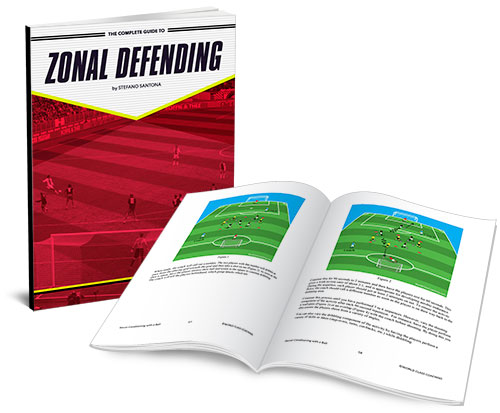
TABLE OF CONTENTS
Part One
INTRODUCTION
ZONAL DEFENDING EXERCISES WITHOUT A BALL
ZONAL DEFENDING EXERCISES WITH A BALL
Part Two
ZONAL DEFENDING IN THE 4-4-2
ZONAL DEFENDING IN THE 4-3-3
Part Three
ZONAL DEFENDING IN THE 4-5-1
ZONAL DEFENDING IN THE 4-2-3-1
CONCLUSION
INTRODUCTION
Structuring the spaces of the playing field is considered a fundamental component in the process of creating a competitive football club and it is an essential function of any collective sports team. Providing structure is manifested through the understanding and occupation of the most appropriate spaces by the individual athlete and collective team in every situation or problem that appears in the game, where the individual and team place themselves with the intuition to exploit spacial and numerical advantage in the various danger zones of the pitch.
In an effort to obtain a structured and cohesive defensive organization, coaches often think of several different ways to train defences that will become efficient and impenetrable, even though that is a utopian scenario. With zonal defending, the team structures itself in a tight shape, with the lines in close proximity to each other and in accordance with the movement of the ball--which is one of the primary references of zonal marking. Keeping in mind that football is a collective sport, it is important to remember that it is possible to attack through defending and to defend through attacking. Having this in mind, it is imperative to think about controlling the game even without having possession of the ball. Manipulating the opponent in the different moments of the game at the highest level is a fundamental ability for the individual player, as well as for the collective team.
In order to better understand the complexity of football, it is necessary to break down the game into moments, i.e., offensive, defensive, offensive transition, and defensive transition. Of these moments, the most critical parts of the game are found in the transitions and the defensive moments. The team that is in defensive transition or in the defensive moment of the game does not have possession of the ball, however this does not mean that they are not in control of the game. It is possible to have control of the game even without the ball, and, even though it is complex, it is not complicated.
The defensive organization of a team will only be truly collective when the actions performed by every single one of the eleven players are made towards a common reference or ideal, where the individual tasks of the players are related, regulated with, and dependent on each other. It is the only way that the collective unit will prevail over the individual quality of the units that form the group. Thus, it is necessary to build principles of the game that define the collective behaviours of the group. Football is an unpredictable game--it doesn’t allow for planned movements throughout the duration of a match. Instead, it is through building principles that the players will obtain an ability to react effectively in the different situations that the game offers.
When a team is attacking, it looks to increase the playing space in the pitch, to occupy the corridors of the field, and to create width and depth through the lines. When a team is defending, it looks to make the pitch smaller by reducing the playing space allowed to the opposing team. The main idea is to reduce the space between the lines and obtain numerical advantage in the sectors closest to the ball. Based on these principles, the main references for defensive positioning for the entire collective group are the following:
• The spaces are the big target for marking
• The biggest concern is to collectively close the most valuable spaces (closest to the ball) and thus condition the opponent
• The position of the ball and the position of the teammates are the biggest references
• Every player, in coordination with his teammates, has to close different spaces, in accordance with the position of the ball
• The permanent existence of a system of successive covering between players is a vital aspect, which is achieved through good organization of the lines
• It is important to pressure the player in possession of the ball, in order to reduce the time and space available for execution
• The careful and intelligent occupation of the most valuable spaces which consequently allows a team to control the opponents without possession of the ball
• Any tight marking of an opponent without possession of the ball is always circumstantial and a consequence of rational occupation of space
• There is a bigger need of effective visual and verbal communication in the defensive moment of the game--especially for the player that pressures, the player that instructs the teammate to press, for the player that covers, and for the player that covers the player who is already covering
Zonal defending can most certainly be considered the best way to defend, as the concern here is the space being occupied and not the opposing players. A space that can be controlled without having possession of the ball, thus we can influence the player with the ball, and obtain control of the spaces. In order to achieve this high level of collective functioning, it is necessary not only to train, but to train with immense quality, with the focus being on what the athlete learns, and not so much on what or how it is trained. It is a teaching process, and if one individual does not understand the concept of zonal defending, the function of the group will collapse.
In this book we can see several samples of exercises that coaches can incorporate into their sessions according to their team’s needs and philosophy, with some specific exercises for different formations that coaches may utilise. Nevertheless, do not forget that the most important are the principles, and these do not significantly change according to formation utilised.
EXERCISES WITHOUT BALL FOR IMPROVEMENT IN ZONAL DEFENDING
DEFEND YOUR GATE – 4 PLAYERS
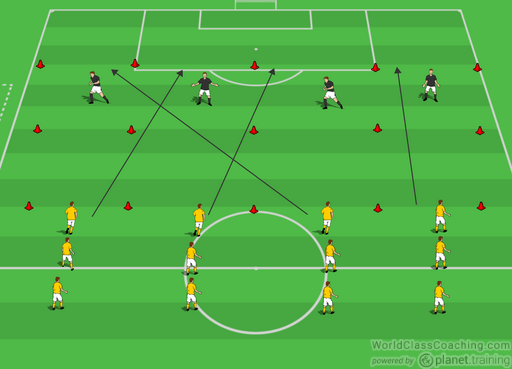
Area Size:
Different geometric sizes depending on age and technical quality of the players.
Time:
5-10 minutes
Objectives:
• To run quickly through the gate;
• To touch the players that are running through your gate;
• To choose a gate (after change of direction too);
• Just a little bit of work involving the lateral vision;
• Develop the ability to control your zone.
Execution:
This exercise is about the ability to run through a gate (it is like the zone that defender has to cover during the match).
It is possible to play this game with two different teams. The team that scores more points running through the gates wins the challenge.
It is a good exercise if you are playing a four player defense.
DEFEND YOUR GATE – 3 PLAYERS
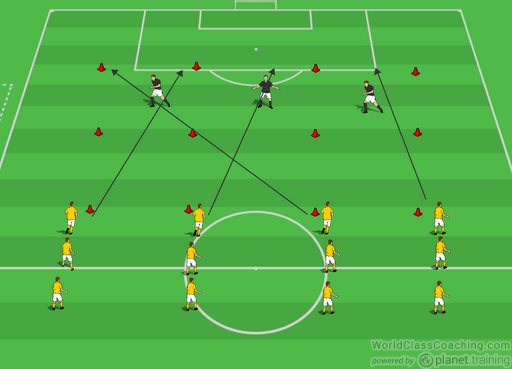
Area Size:
Different geometric sizes depending on age and technical quality of the players.
Time:
5-10 minutes
Objectives:
• To run quickly through the gate;
• To touch the players that are running through your gate;
• To choose a gate (after change of direction too);
• Just a little bit of work involving the lateral vision;
• Develop the ability to control your zone.
Execution:
This exercise is about the ability to run through a gate (it is like the zone that defender has to cover during the match).
It is possible to play this game with two different teams. The team that scores more point running through the gates wins the challenge.
It is a good exercise if you are playing a 3 players defense.
EXERCISES WITH A BALL
DEFEND YOUR GATE – 4 PLAYERS

Area Size:
Different geometric sizes depending on age and technical quality of the players.
Time:
5-10 minutes
Objectives:
• To drive quickly through the gate;
• To stop the player that is dribbling through your gate;
• To choose a gate (after change of direction too);
• Just a little bit of work involving the lateral vision;
• Develop the ability to control your zone.
Execution:
This exercise is about the ability to dribble through a gate (it is like the zone that defender has to cover during the match).
It is possible to play this game with two different teams. The team that scores more points driving through the gates wins the challenge.
DEFEND YOUR GATE – 3 PLAYERS
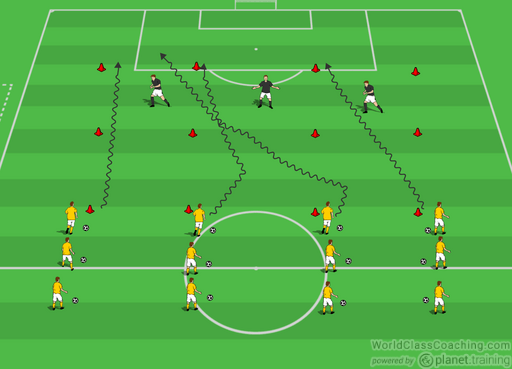
Area Size:
Different geometric sizes depending on age and technical quality of the players.
Time:
5-10 minutes
Objectives:
• To drive quickly through the gate;
• To touch the player that is dribbling through your gate;
• To choose a gate (after change of direction too);
• Just a little bit of work involving the lateral vision;
• Develop the ability to control your zone.
Execution:
This exercise is about the ability to run through a gate (it is like the zone that defender has to cover during the match).
It is possible to play this game with two different teams. The team that scores more points driving through the gates wins the challenge.
DEFEND YOUR GATE (3 DEFENDERS – 4 GATES)
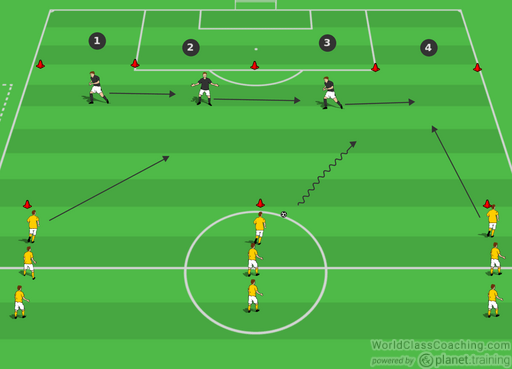
Area Size:
Different geometric sizes depending on age and technical quality of the players.
Time:
5-10 minutes
Objectives:
• To drive quickly through the gate;
• To stop the player that is dribbling through your gate;
• To choose a gate (after change of direction too);
• To pass the ball to a free player (finding the space to drive through);
• Just a little bit of work involving the lateral vision;
• Develop the ability to control your zone.
Execution:
This exercise is about the ability to run through a gate (it is like the zone that defender has to cover during the match).
This is good to train three defenders playing a four player defense.
It is possible to play this game with two different teams. The team that scores more points driving through the gates wins the challenge.
Offensive team has to find a space while the defensive team has to close all the gates.
It is good to play the game in 15-20 seconds.
DEFEND YOUR GATE (2 DEFENDERS – 3 GATES)
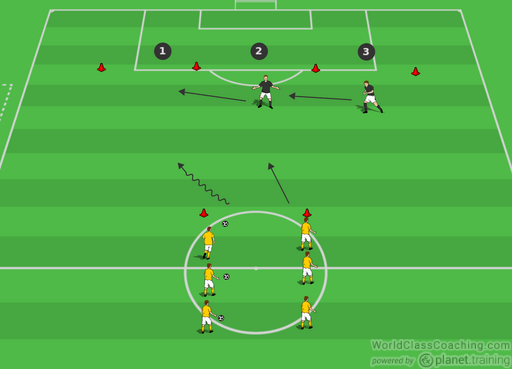
Area Size:
Different geometric sizes depending on age and technical quality of the players.
Time:
5-10 minutes
Objectives:
• To drive quickly through the gate;
• To stop the player that is dribbling through your gate;
• To choose a gate (after change of direction too);
• To pass the ball to a free player (finding the space to drive through);
• Just a little bit of work involving the lateral vision;
• Develop the ability to control your zone.
Execution:
This exercise is about the ability to run through a gate (it is like the zone that defender has to cover during the match).
This is good to train 2 defenders playing the 3 players-defense.
It is possible to play this game with two different teams. The team that scores more points driving through the gates wins the challenge.
Offensive team has to find a space while the defensive team has to close all the gates.
It is good to play the game in 15-20 seconds.
DEFEND YOUR GATE AND INTERECEPT THE PASSESS (3 DEFENDERS – 4 GATES)
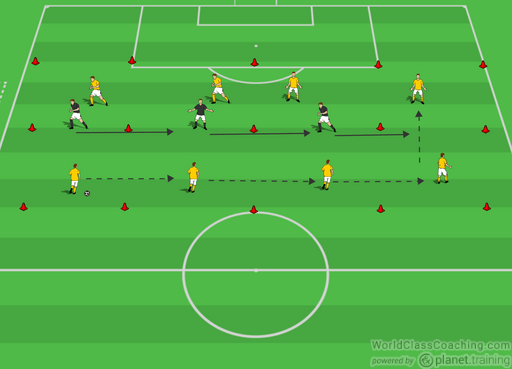
Area Size:
Different geometric sizes depending on age and technical quality of the players.
Time:
5-10 minutes
Objectives:
• To pass the ball quick through the gate;
• To stop the pass if it is your gate;
• To choose the right moment to pass;
• To pass the ball to a free player;
• Just a little bit of work involving the lateral vision;
• Just a little bit of work on change of direction;
• Develop the ability to control your zone;
Execution:
This exercise is about the ability to pass the ball through a gate (it is like the zone that defender has to cover during the match).
This is good to train three defenders playing a four player defense.
It is possible to play this game with two different teams. The team that scores more points driving through the gates wins the challenge.
Offensive team has to find a space while the defensive team has to close all the gates.
It is good to play the game in 15-20 seconds.
DEFEND YOUR GATE AND INTERECEPT THE PASSESS (2 DEFENDERS – 4 GATES)
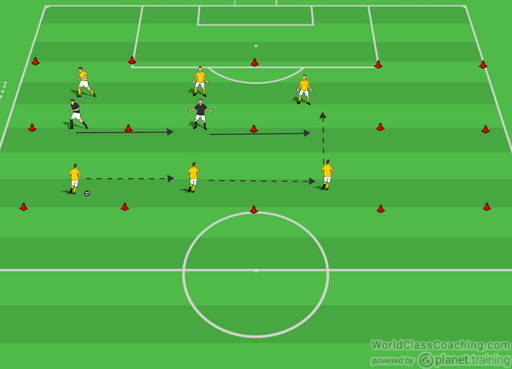
Area Size:
Different geometric sizes depending on age and technical quality of the players.
Time:
5-10 minutes
Objectives:
• To pass the ball quick through the gate;
• To stop the pass if it is your gate;
• To choose the right moment to pass;
• To pass the ball to a free player;
• Just a little bit of work involving the lateral vision;
• Just a little bit of work on change of direction;
• Develop the ability to control your zone;
Execution:
This exercise is about the ability to pass the ball through a gate (it is like the zone that defender has to cover during the match).
This is good to train two defenders playing a three or four player defense.
It is possible to play this game with two different teams. The team that scores more points driving through the gates wins the challenge.
Offensive team has to find a space while the defensive team has to close all the gates.
It is good to play the game in 15-20 seconds.
ZONAL DEFENDING FOR RIGHT AND LEFT BACK
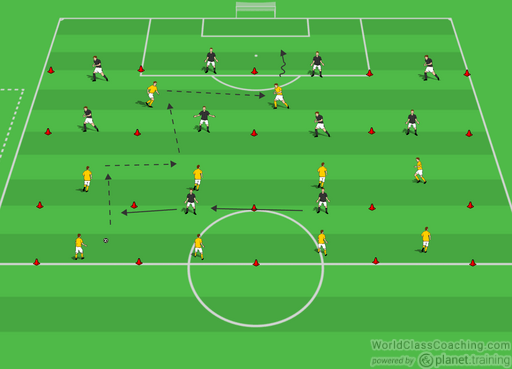
Area Size:
Different geometric sizes depending on age and technical quality of the players.
Time:
15-20 minutes
Objectives:
• To move the ball quickly;
• To find the lane useful for attacking;
• To pass the ball to a free player;
• Just a little bit of work involving the lateral vision;
• Just a little bit of work on change of direction;
• Develop the ability to control your zone;
Execution
The right back is dribbling the ball (n°.1 in the picture), but when he finds the black left back
he chooses to pass the ball to the player in the box (n°2 in the picture). When the ball is in the box the team that has the possession has to find the space and score a point (n°3 in the picture).
This exercise is about the ability to control the space as a team (it is like the lateral zone that defender has to cover during the match).
This is good to train 4 defenders playing the 4 players-defense, with an addition of 2 players.
It is possible to play this game with two different teams. The team that scores more points driving the ball behind the opponent team’s line wins the challenge.
It is good to play the game in 15-20 seconds.
ZONAL DEFENDING FOR RIGHT AND LEFT BACK + GK
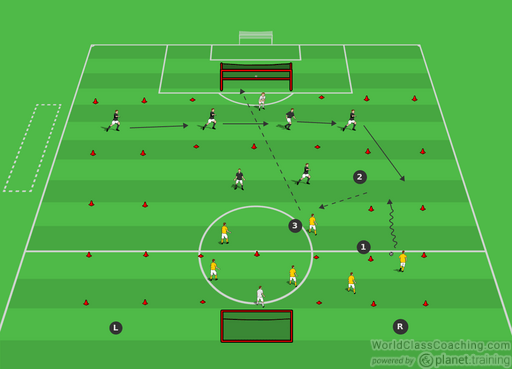
Area Size:
Different geometric sizes depending on age and technical quality of the players.
Time:
15-20 minutes
Objectives:
• To move the ball quickly;
• To find the lane useful for attacking;
• To pass the ball to a free player;
• Just a little bit of work involving the lateral vision;
• Just a little bit of work on change of direction;
• Develop the ability to control your zone;
Execution
The right back is dribbling the ball (n°.1 in the picture), but when he finds the black left back
he chooses to pass the ball to the player in the box (n°2 in the picture). When the ball is in the box the team that has the possession has to find the space and shoot (n°3 in the picture).
This exercise is about the ability to control the space as a team (it is like the lateral zone that defender has to cover during the match).
This is good to train four defenders playing a four player defense, with an addition of two players.
It is very important to involve the GK and ask him to play quick balls (max 3 seconds holding the ball).
It is possible to play this game with two different teams. The team that scores more points driving the ball behind the opponent team’s line wins the challenge.
It is good to play the game in 15-20 seconds.


